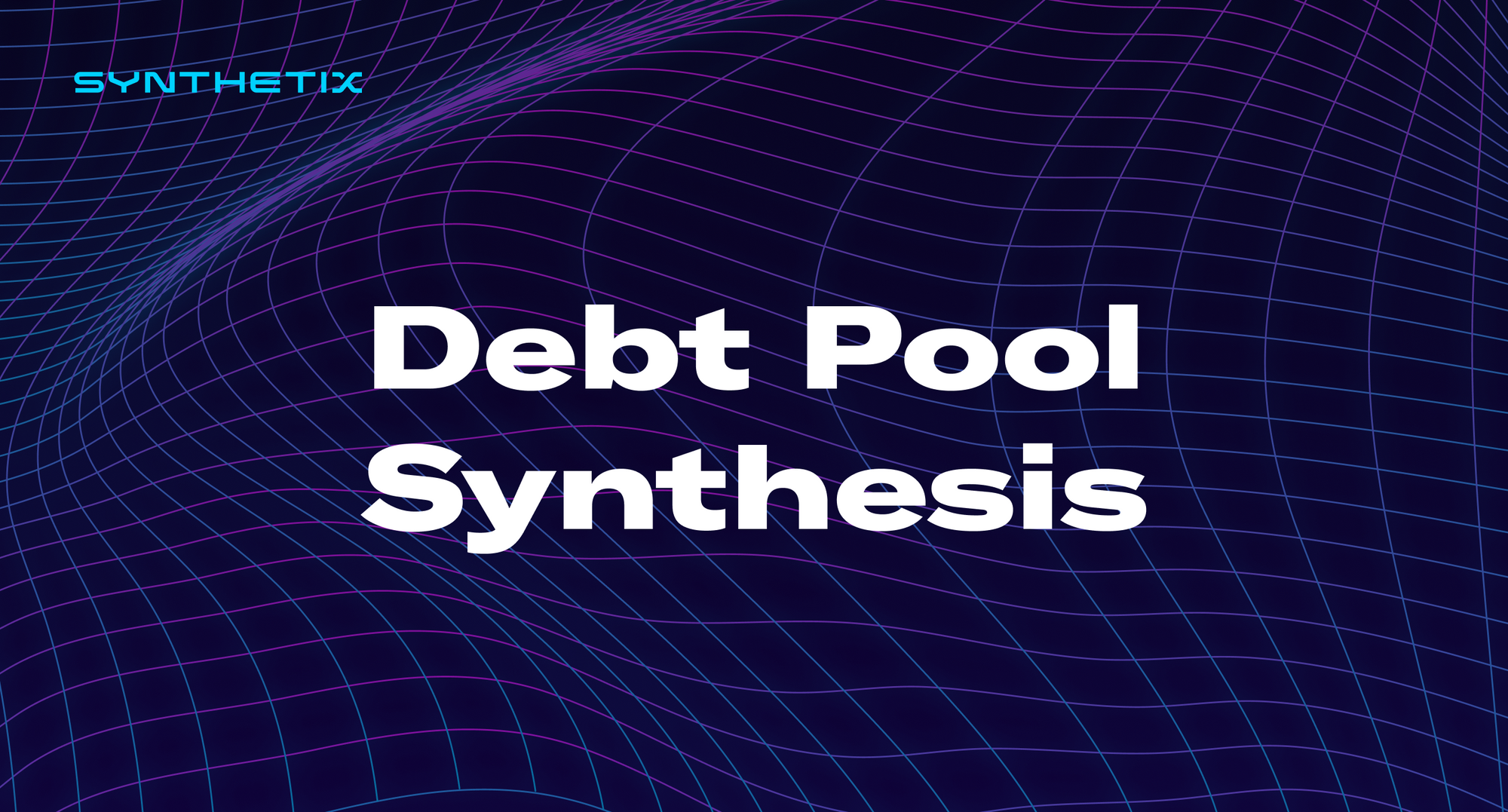Debt Pool Synthesis

Before jumping in a quick reminder on some of the naming conventions used in this post.
V2x refers to the remaining scope to be delivered in the current Synthetix protocol
V3 refers to the redesigned contract architecture to be deployed next year
V3GM refers to the new generalised governance module developed by Synthetix
Debt Pool Synthesis refers to the merging of the L1/L2 debt pools
Over the last few months, much of the proposed scope for phase one of V2x has been delivered, as well as many additional items that were not contemplated when we initiated the V2x roadmap earlier in the year.
Phase one of V2x was focused on implementing new features, fixing existing issues and solving tech debt within the protocol. In addition to this, much of the engineering work on SIP-80 (Synthetic Futures) has been completed. An update on the progress of Futures following the recent OVM regenesis and the incentivised testnet competition will be published later this week. The community is eager for an update on the futures timeline and this upcoming post will cover the lessons from the testnet as well as the remaining scope to be completed before futures can be deployed to mainnet.
The second phase of V2x is the Debt Pool Synthesis. This is the process where the two debt pools on L1 and L2 will be merged and Synth fungibility will be restored across both networks. This post will describe in detail the process of implementing this change. But first a quick recap of the Phase One V2x scope delivered since August.
Mirfak; SIP-174 - Deprecated Synth Redemption, SIP-142 - Deprecating EtherCollateral loans, SIP-170 - Inflation Diversion for L2 Incentives
Wezen; SIP-169 - Deprecate low volume synths, SIP-158 - Deprecate iSynths
Sargas; SIP-135 - L2 Shorting
Kaus; SIP-187 - Fix Partial Synth Updates In Debt Cache
Avior; SIP-182 - Wrappr Factory
Alkaid; SIP-120 - TWAP Exchange Function, SIP-189 - Add LUSD/sUSD Wrappr on L2
Governance Changes; SIP-155 - Deprecating the synthetixDAO, SIP-157 - ambassadorDAO Mandate, SIP-159 - Formalize Thales Governance, SIP-160 - Updated SIP Workflow, SIP-167 - L2 Bridged Governance, SIP-168 - Governance Participation Program, SIP-177 - Formalize Kwenta TreasuryDAO, SIP-178 - Formalize Kwenta Interim Council, SIP-179 - Kwenta Independence
While there have been some delays due to a number of factors including scope creep the additional engineers that have joined the CC's have enabled us to maintain a delivery cadence that has been consistently high for over six months now. Given the overwhelming technical debt within the V2x protocol this is an exceptional achievement. Let's move on to the Debt Pool Synthetis. There are five major components within this process.
Debt Shares
When we first proposed the Synthetix architecture in the Havven whitepaper there were a number of unsolved problems. One of these was how to track on-chain the debt percentage of each staker in the network. This is a challenging problem because you cannot store and iterate over every mint and burn across the network to work out the current state. We eventually designed a system called the debt register which allowed us to roll up every mint and burn into a single calculation to determine the debt percentage of each staker. This design has since been superseded by tokenised tracking of positions like those used by Compound and Aave. The debt register is not compatible with a multi-chain debt pool so it is being replaced by a new tokenised debt tracking system called debt shares.
New Oracles
Chainlink is developing two novel oracles for the Debt Synthesis, the first oracle will read the size of the debt pool on each network and then combine these values so that both networks are in sync with respect to the combined debt pool size.|
The second oracle will read the total supply of the debt shares contract described above and push the combined total supply of debt shares on both networks onto each chain.
Debt Pool Synthesis
Once these components are in place we can initiate the Synthesis, we will pause the system and update the debt percentage calculations for both chains to reflect the total debt and the total supply of debt shares. This will mean stakers on each network will be responsible for the debt on both networks regardless of which network they are staking on.
Restoring Fungibility with Teleporters
After the Debt Pool Synthesis is complete there is an additional SIP required to restore fungibility of Synths across the two networks. Standard bridges do not support a combined debt pool because the usual way to transport tokens between L1 and L2 is to lock them on one network and create a new IOU token on the other network. The issue with this is that this would require any debt calculation to ignore the Synths in the bridge, this presents integration issues for other networks who may not be aware that the total supply of Synths is not readable from the token contract. The solution is to burn the Synth on one network and re-mint it on the other network, like how star trek style teleportation works, hence "synth teleporters". Once the teleporters are implemented any synth can move between networks as needed. Please note that transfers from L2 to L1 will initially be subject to the seven day withdraw delay on Optimism, but eventually, a fast withdrawal teleporter should be implemented.
Debt Migration
The final SIP to be implemented as part of phase two is debt migration, this will allow any staker to migrate their debt position from L1 to L2 without needing to burn their debt. It will transfer their entire SNX balance, both escrowed and unlocked to L2 while maintaining their c-ratio. This reduces the likelihood of a supply crunch of sUSD on L1 and will allow for a smooth migration of Synth liquidity. Though it does mean we could have a temporary imbalance of collateral on L2 and Synths on L1, though wrappers on L2 should ensure there is sufficient liquidity to liquidate positions on L2.
Timelines
Now the most important question is, what is the timeline for this work to be completed? It is likely that debt shares will be done before the end of the year, but the rest of the scope will need to be delivered early next year. Though the CC's are working as hard as possible to close out each SIP and get them audited before we wind up 2021. With liquidations being enabled on L2 this week there is likely to be a push to migrate more inflation and lower the c-ratio on L2 to get some additional Synth liquidity onto the Optimism network.
Conclusion
Given that the V3GM is also scheduled to be deployed for V2x governance early next year there are still a lot of changes slated for the current network. However, the V3 squad is making amazing progress on the architecture and has started development on the V3GM already so as always there are multiple simultaneous threads in play for the CC's. The last five weeks of the year are going to be incredibly busy.

